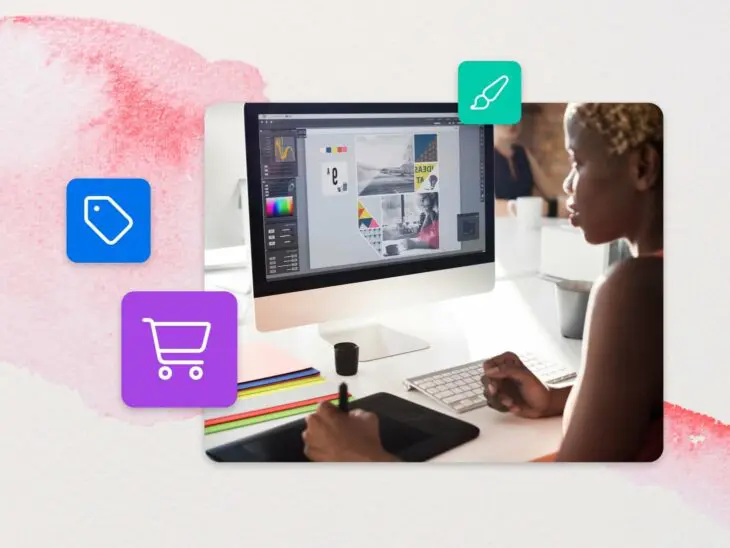There are at least a million ways to make money online (trust us, we counted).

If you’re looking to start an online business – and make some cash in the process – there’s no better place to start than your own skills, hobbies, and passions. If you have a talent for art, that can be your chance to start an online empire – or at least make a few extra bucks.
Many people sell digital art on the web, but because there are so many ways to do so, it can be an intimidating space for a beginner. But fear not! Our guide below covers everything you need to know about how to sell digital art online. All you need to do is what you do best: create art.
Let’s get started!
What Kinds Of Digital Art Can You Sell?
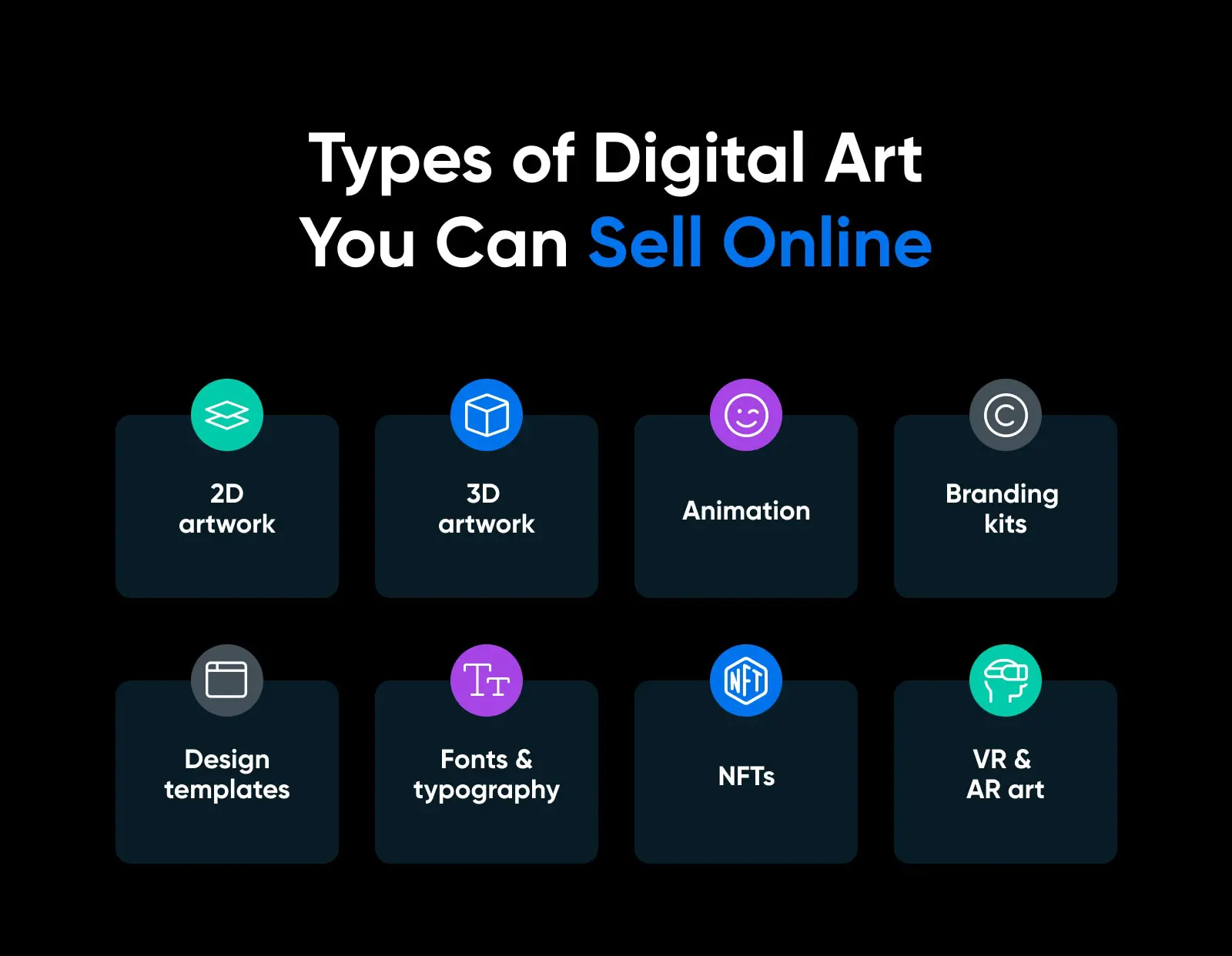
No matter what type of digital art you create, you can probably sell it online. Some common and popular digital art styles that are found in online marketplaces and e-commerce sites include:
- 2D artwork, like photography, illustrations, digital paintings, vector art, pixel art, and concept art for video games and movies. This can even be physical art that gets scanned or recreated in digital form.
- 3D artwork, which can include computer graphics, mixed media, and architectural models, and more.
- Animation, which can be used in video production, presentations, or even in interactive media like video games.
- Branding kits, which can include logos, fonts, website designs, and other graphic design assets businesses use to build their brands online.
- Design templates, If you have a knack for design, selling templates for websites, presentations, business cards, social media posts, and other uses can be quite profitable.
- Fonts and typography, which can be used for branding or web design.
- NFTs, or non-fungible tokens, which have emerged as a popular way for artists to sell their digital art. This can include any type of digital art, but it’s commonly used for unique or limited-edition pieces.
- VR and AR art, like social media filters, immersive experiences, or digital objects.
Can You Make A Profit Selling Digital Art Online?
Yes! Online art sales were estimated to generate $13.6 billion in 2021, up from $7.9 billion in 2020. More and more people are buying art online, so it’s definitely possible to make a profit selling digital art – and many people do! But it can take significant effort, skill, marketing acumen, and often, a little bit of luck.
Below are some tips and strategies you can use to maximize your profits.
- Develop your skills – As the old saying goes, practice makes perfect! To sell your art, it needs to be high quality. That means spending time practicing your craft and developing your unique style, which will help you stand out and create a following.
- Know your market – Different types of art sell better on different platforms. Research to understand what types of art are popular in your chosen marketplace (more on that further down).
- Market and promote your art – Just uploading your art and hoping buyers will find it is not enough. Use social media, email newsletters, and other marketing strategies to promote your work. It’s also a good idea to build a strong brand and consistent portfolio. Having a cohesive look and feel to your work can make you more recognizable and professional to potential buyers.
- Diversify your income – As we’ll explore in more detail below, there are tons of ways to sell digital art. Don’t limit yourself, or you risk limiting your profits! Consider selling different types of products, such as art prints, t-shirts, or digital downloads, and offering services like custom commissions or tutorials. You can also sell your work on multiple platforms to reach a wider audience.
- Take good care of your customers – When you provide top-tier customer service and treat your customers well, they’re more likely to become repeat customers and refer others to you. Respond quickly to questions from potential buyers, work hard to resolve issues, and deliver high-quality products on time.
- Take advantage of new technologies – For example, NFTs can allow artists to sell their work for higher prices than traditional digital prints. However, keep in mind that trends in technology can be volatile and speculative–NFTs are already on their way out, according to some experts.
How Do I Know If My Art Will Sell?
Well, you don’t. To be perfectly honest, the art market can be unpredictable and subjective. But you can up the odds by practicing as much as possible to make high-quality works of art, having a unique style that sets you apart from other artists, and selling your art in many different forms that appeal to different audiences. Marketing can also help you find the right audiences to love and appreciate your work.
What sells often isn’t just the artwork itself but the story and personality behind it. Building a strong personal brand and connecting with your audience can play a significant role in your commercial success. Always continue learning, experimenting, and refining your craft, and don’t be discouraged by initial slow sales–it can take time to find your market and hit your stride.
How Much Should I Charge?
Pricing your digital art can be a tricky process, and there are a lot of variables to consider. Here are some factors that might influence how much you should charge:
- Time spent – Consider the time you spent creating the artwork. What would be a reasonable hourly rate for your work? This can be a helpful starting point.
- Your skill level – Artists with a high level of skill or years of experience can generally charge more for their work.
- Costs – If there are any costs involved in creating the artwork, such as software subscriptions or hardware, these should be factored into the price.
- Market rates – Research what other artists with similar styles and experience levels are charging for comparable work. This can give you an idea of what customers might be willing to pay.
Safety Tips For Selling Digital Artworks Online
There are some potential dangers associated with selling digital art (or any other product) online. Some main risks to watch out for are scams, theft, and privacy concerns. Here are some tips to protect yourself.
To protect yourself from scams:
- Be aware of common scams, such as chargebacks or buyers asking to use unusual payment methods. If something seems suspicious, it’s best to err on the side of caution.
- Use a secure, trusted payment platform to handle transactions. This protects both you and your customers.
- Clearly state your terms of service on your website or platform. This should include your policies on refunds, exchanges, and personal use policies (i.e., what the buyer is allowed to do with your art).
- Keep records of all your sales and interactions with customers. This can be useful in case of disputes or for tax purposes.
To protect yourself from theft:
- Watermark all your original art. A watermark can discourage people from stealing your images because it makes it harder for them to be used without permission. It doesn’t have to be large or obtrusive, just enough to protect your work.
- Use mockups or low-resolution images as previews. When displaying your work online, lower-resolution images are suitable for viewing but not for printing. This will further deter theft.
- Include a copyright notice on your website and on the image itself if possible. This reminds people that your work is protected by law.
- Always keep backups of your original files. If your website or the platform you sell on were ever to crash or be hacked, you wouldn’t lose your original work.
Mockup
A mockup is a static design used to showcase how a website or an application might look. People use mockups to help evaluate potential designs without coding the actual application or site.
Read MoreTo protect your privacy and personal data:
- Be cautious about how much personal information you share online. Never give out more information than necessary.
5 Ways To Sell Digital Art Online
Digital artists have many ways they can sell their art online, though in some cases, they may be limited by exactly what type of art they create. Below, you’ll find some of the most common ways creators sell their digital art – but know that this isn’t a comprehensive list, and there are many other ways to sell, especially if you have a particular niche type of art that appeals to a specific community.
1. Set Up An Online Store
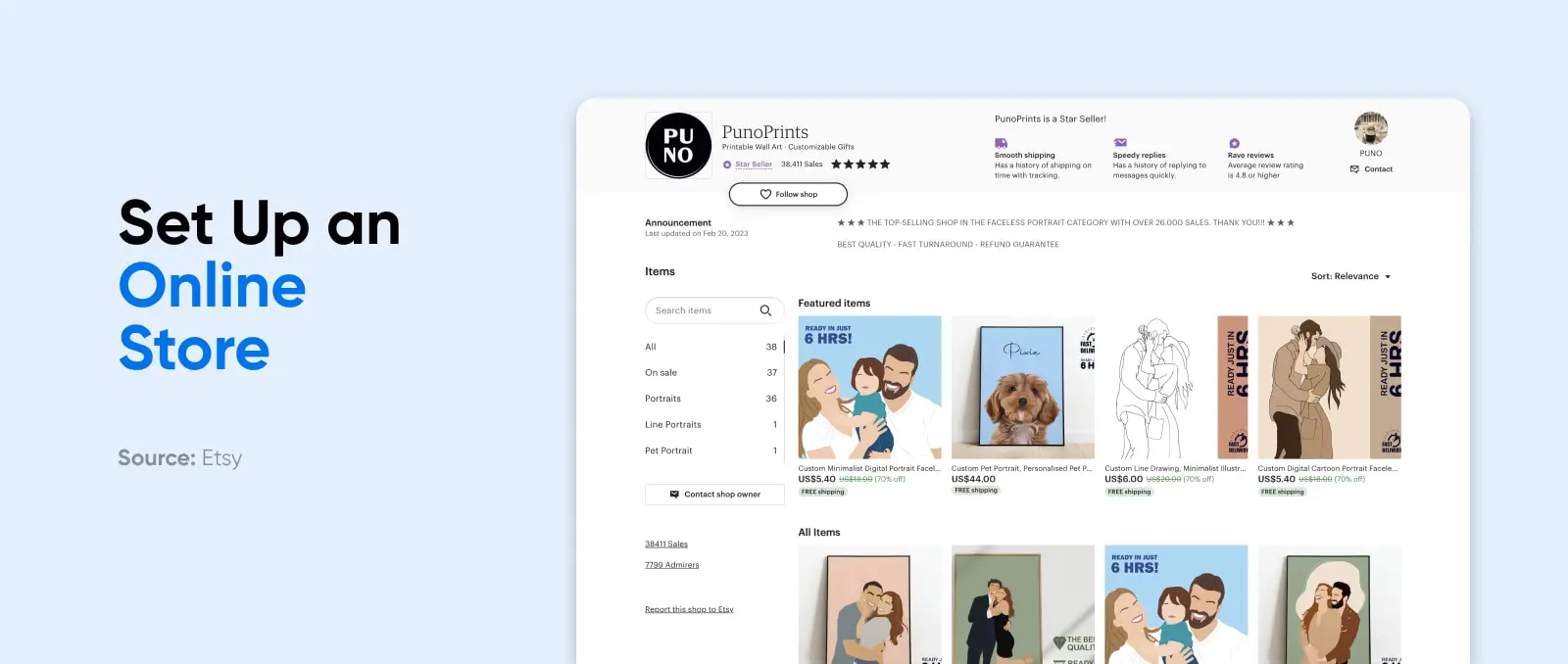
Setting up an online store can be labor-intensive and time-consuming, but it’s still a great choice, especially for artists who have digital products to sell as downloadables, like digital art prints.
There are some ways you can save time and effort in setting up an online store – for example, instead of creating your website from scratch, you can use a website builder like Wix or WordPress, then install an e-commerce plugin like WooCommerce to start selling your art.
WooCommerce
WooCommerce is a WordPress plugin designed for e-commerce needs. This tool can enable website owners to start selling products in a flexible, customizable online store.
Read MoreOr you can save even more time by setting up a page on an existing online marketplace, like Shopify or Etsy. You can even do a combination of these to reach a wider audience – you can build your website and still have an Etsy shop to capture potential buyers searching Etsy for products like yours.
Selling digital art through an online store can be a good option for artists who have a large body of work they want to sell, as well as those who want to reach a global audience. It’s also a good option for artists who prefer to create work at their own pace.
| Pros and Cons of Selling Digital Art in an Online Store | |
| Pros | Cons |
|
|
2. Offer Commissions
Offering commissions means you create custom artwork for clients based on their specific requests. Here’s how the process works:
- You use your website, social media, and other channels to let people know you’re open for commissions.
- When someone is interested in commissioning you, they’ll contact you to discuss what they want. You’ll need to discuss details like the subject, style, size, timeline, and price.
- Once you’ve agreed on the basics, you can formalize the agreement. This should include a contract outlining the terms of the commission, including payment terms, timelines, what happens if the client isn’t satisfied, etc.
- After the terms are set, you can start working on the commission. You can provide progress updates to the client, and they may want to request changes or revisions.
- Once the artwork is completed and the client is satisfied, you deliver the final digital files.
Taking commissions can be a good option for artists who enjoy working on custom projects and interacting directly with clients. It can also be a good option for artists specializing in a specific type of art that is in demand for custom work, such as portraits, branding, or concept art for video games and films.
| Pros and Cons of Selling Digital Art by Offering Commissions | |
| Pros | Cons |
|
|
3. Sell Your Art As NFTs
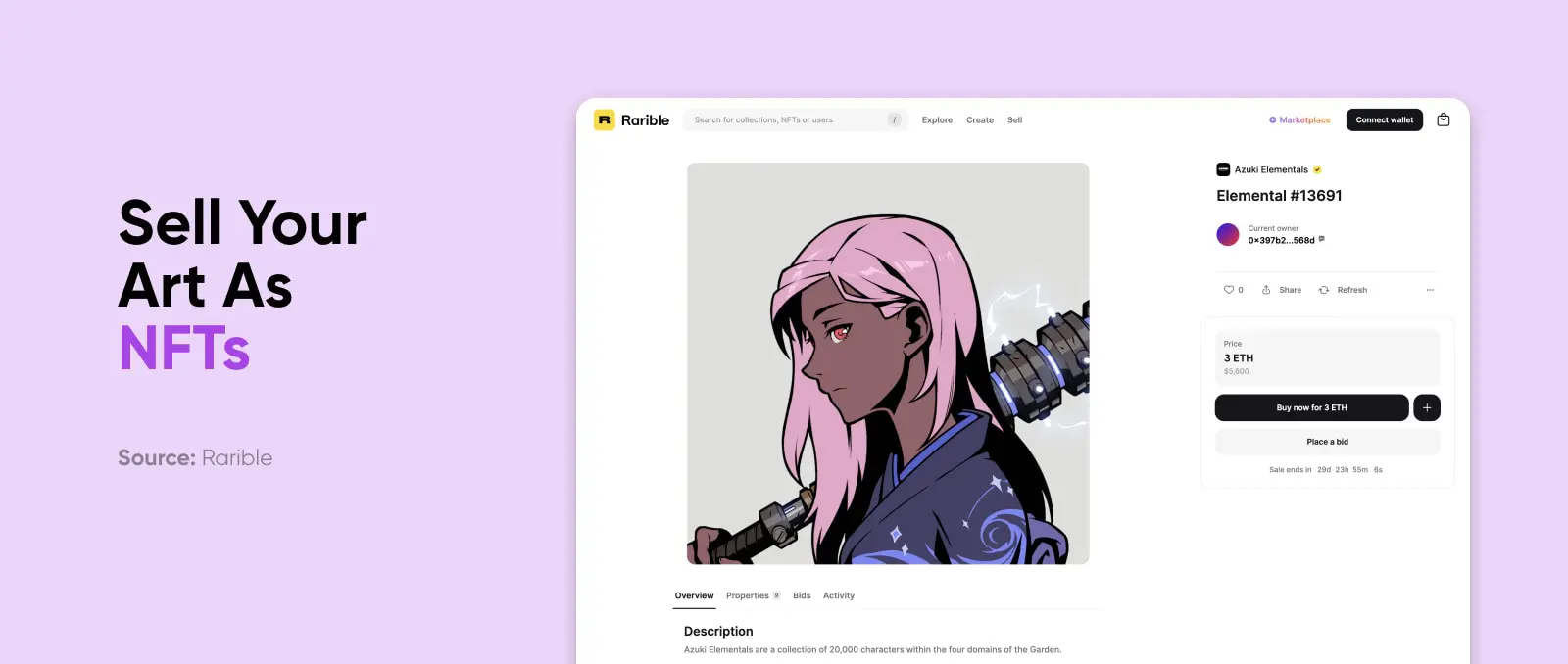
NFTs burst onto the digital art scene in 2014 but rose in popularity in 2020 and 2021 after a few high-profile (and high-value) NFT sales. Selling your art as NFTs involves creating unique tokens on a blockchain that represent ownership of a specific piece of digital art. You’ll create your art, just like you already do, but then, it needs to be “minted,” meaning you create a new token on the blockchain that represents your art. This usually involves uploading your artwork to an NFT marketplace, adding metadata about the artwork (like its name, description, and your name as the artist), and paying a fee in cryptocurrency.
You can then list your NFT for sale, selling it at a fixed price or auction style, where it goes to the highest bidder. When someone buys your NFT, the token that represents your artwork is transferred to their digital wallet. This transaction is recorded on the blockchain, providing a permanent record of the sale.
Selling art as NFTs can be a good option for digital artists interested in exploring new technology and who want to sell their work in a marketplace that allows for unique ownership. It’s also attractive to artists who create work that can benefit from being tied to a blockchain, such as digital art that’s interactive or that changes over time.
| Pros and Cons of Selling Digital Art as NFTs | |
| Pros | Cons |
|
|
4. Sell Canvas Prints And Decor
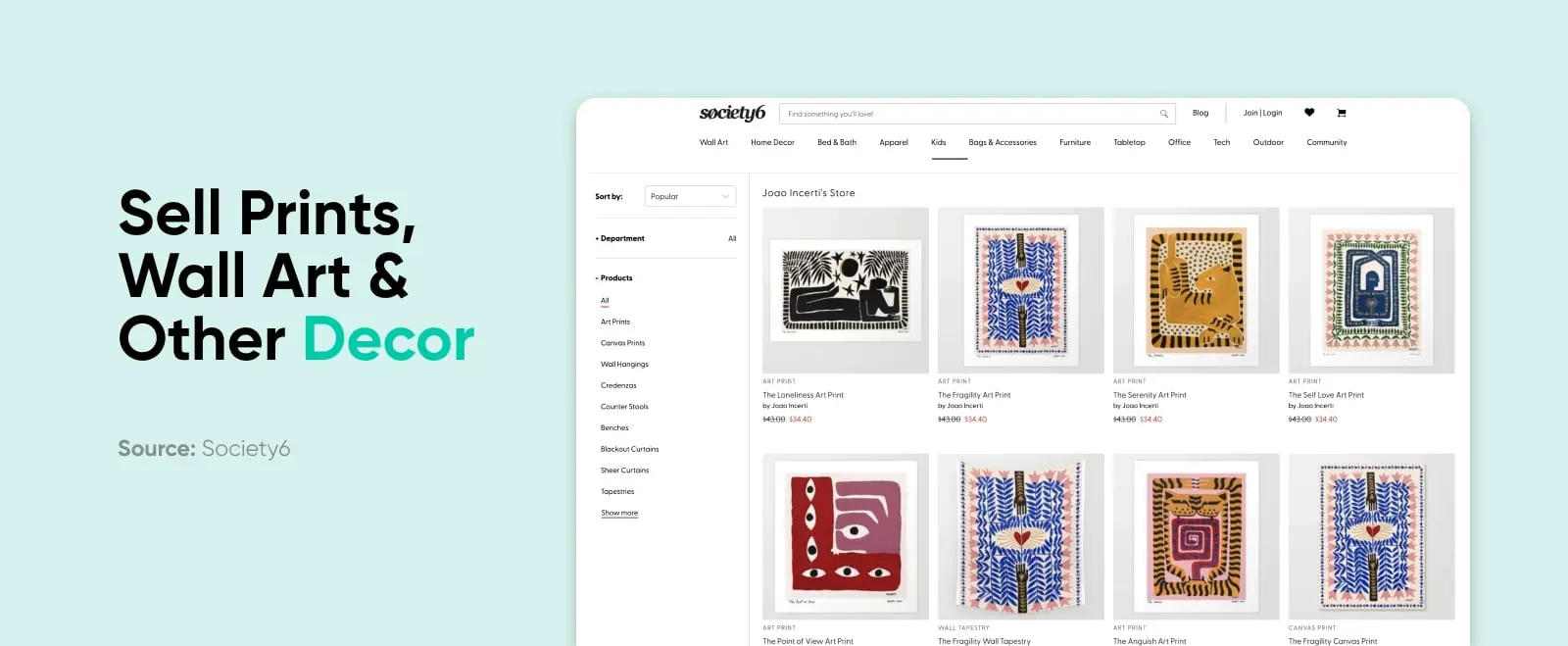
Selling digital art as physical products such as canvas prints, wall art, posters, cards, stickers, and other decor items involves turning your digital creations into tangible items that people can put on display.
You’ll need to partner with a printing company to turn your digital art into physical products. You can choose to work with a local printer or use an online service. Some online services, like Society6 or Redbubble, also handle sales and shipping for you. Then, you need to upload your art, choose the products you want to offer, set your prices, and write product descriptions.
Selling digital art as physical products can be a good option for artists who want to reach a wider audience. While some people are comfortable buying digital art, many others prefer to have a physical item they can display. It’s also a good option for artists who create work that lends itself well to being displayed on physical products, such as illustrations, typography, or graphic designs.
| Pros and Cons of Selling Digital Art as Physical Prints | |
| Pros | Cons |
|
|
5. Sell Merchandise
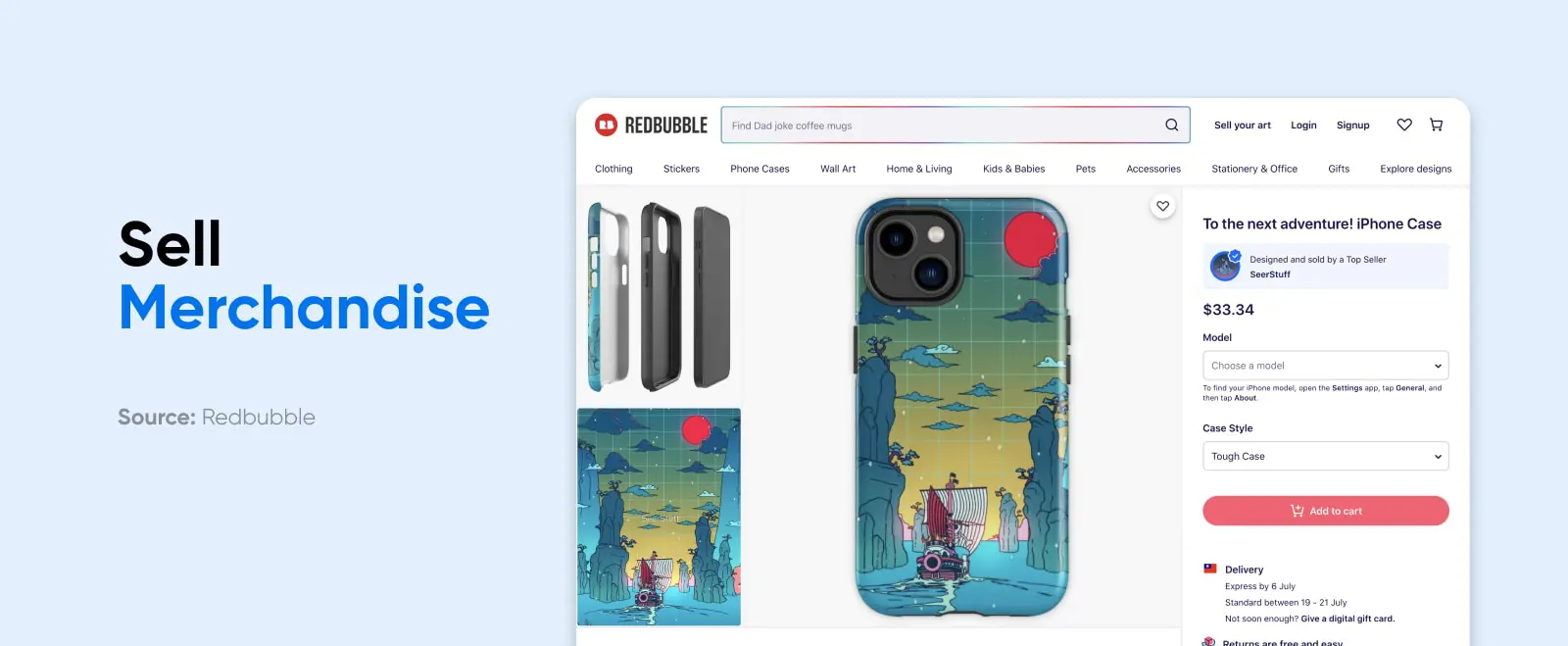
Selling digital art as merchandise means turning your digital creations into products like T-shirts, mugs, stickers, phone cases, notebooks, planners, and more. For this, many artists use Print-On-Demand services (POD) like Redbubble, Society6, or Printify. These platforms handle the printing and shipping of products, making the process more accessible and manageable.
To get started, you just need to choose the products you’ll want to offer, and the options are basically limitless – anything that can display a printable version of your art could conceivably work. Then you can set up your store and start selling!
Artists who already have a following may find selling merchandise particularly profitable since fans are often eager to support their favorite creators. Artists whose work translates well onto merchandise (think bold, striking designs or trendy themes) may also be successful with this approach.
| Pros and Cons of Selling Digital Art as Merchandise | |
| Pros | Cons |
|
|
How To Sell Digital Art Online: A Step-By-Step Guide
So you’re ready to turn your artistic passion into an art business? The tips you’ve learned in this guide will help you with the next steps: Establishing yourself online and selling some art!
1. Make Your Art!
First things first, let your creativity flow! Whether it’s digital paintings, vector art, or 3D models, create something you’re passionate about and others would love to see on their digital or physical walls.

2. Prepare Your Digital Files
Done with creating? Fabulous! Now it’s time to make sure your art is ready for the online marketplace.
For digital downloads, save your artwork in a high-resolution, universally accepted format like JPEG or PNG. If you’re selling prints or merch, ensure your work is high enough resolution to look sharp and vibrant when printed. Also, consider creating appealing previews or thumbnails of your work to make it as eye-catching as possible to anyone browsing your site.
Resolution
In web design, an image’s resolution tells you how many pixels it contains horizontally and vertically. Higher-resolution images tend to be more detailed, but they also have larger file sizes.
Read More3. Choose A Selling Platform
We’ve already covered a lot of platforms in this guide. You can choose just one, or you can use several at once – it all just depends on how much time and effort you want to put into selling your art and the types of people you want to reach. Remember, if you want to reach a large audience, using multiple platforms is the way to go.
Whether you build your own website, create a page or storefront in an online art market, create NFTs, or turn your art into merchandise, this step will take some time – there’s comparing different platforms, deciding how hands-on (or off) you want to be, and whether your business model supports passive income through POD services, or custom commissions where you’re involved at every step.
4. Upload Your Art
This step is like hanging your art in a virtual gallery. Ensure each piece is presented in its best light with high-quality images and thumbnails. Write engaging and clear descriptions, and consider adding fun details – you can talk about your inspiration, process, or the story behind the piece. Don’t forget to price your work! Consider your time, effort, and the going rate for similar works when setting prices.
5. Market Yourself
Lastly, you’re not just selling your art – you’re selling a story, YOUR story. So, unleash your inner influencer and tell people about you and your work.
Use social media platforms, start a blog or a newsletter, collaborate with other artists, or take part in online communities. Show behind-the-scenes of your work, share your successes (and your flops – everyone loves an artist who’s real!), and engage with your followers.
If your art is niche or appeals to a particular target audience, go where that audience tends to “hang out” online, like certain websites or communities. You may also want to invest in search engine optimization (SEO) for your website or storefront, which will help people find you on search engines when looking for specific search terms related to your art.
Final Thoughts
Deciding how to sell your digital art online is kind of like the act of creating art itself – there are infinite paths you can take and no real way to know which is best. But the tips in this guide should help give you some clarity on the best ways to turn your passion into a money-making endeavor. Good luck!

Your Store Deserves WooCommerce Hosting
Sell anything, anywhere, anytime on the world's biggest eCommerce platform.
See Plans